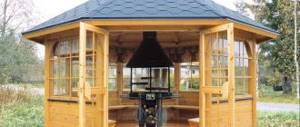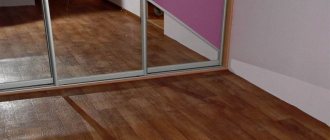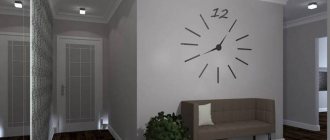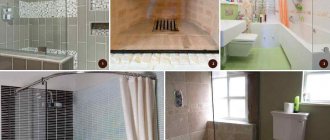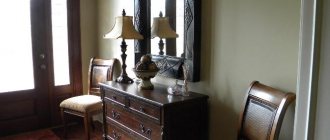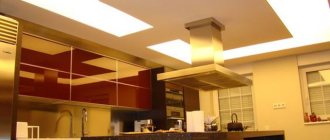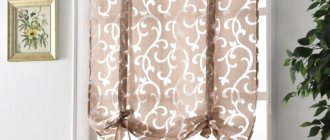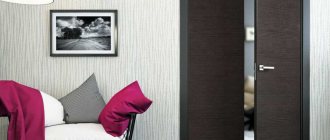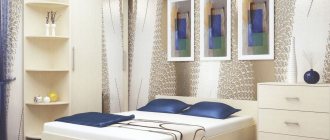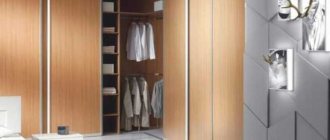In any apartment or house, the hallway serves as a “passage” room. This is both the “face” of the apartment, by which guests can judge the character and tastes of the owners, and its most important “transport” hub. According to standard layouts, all doors to other areas of the home are located in the hallway. Often the dimensions of this room leave much to be desired, so the design will have to be sophisticated in order to fit all the necessary furniture elements and not clutter the space with them.
- Finishes and materials
- Wallpaper or painting
- Color spectrum
- Lighting
- Furniture
- Modern style
- Classic style
- Provence style
- Loft style
- Hallway design 2 square meters
- 3-4 square meters
- 5-6 square meters
- 7-8 square meters
- 9-10 square meters
Finishes and materials
For floor finishing, it is better to abandon outdated linoleum and traditional laminate and parquet in favor of ceramic tiles. This option wins on several points:
- All street dirt on shoes stretches and settles in the hallway. This room, along with the kitchen, is cleaned more often than others. Ceramic or porcelain tiles are not afraid of either water or detergents. Frequent cleaning will not affect their appearance either.
- In winter, not only water settles on shoes, but also aggressive agents that utility workers use to treat streets. Such substances can cause irreparable harm to expensive laminate flooring, while they are of no use to floor tiles.
Modern laminate production technologies also allow us to talk about its strength, but the material is characterized by increased “slipperiness,” which is undesirable in the hallway. Parquet boards are made from natural wood, therefore, despite the special treatment of the material, it is most susceptible to moisture. This type of covering is not suitable for a hallway. The carpet looks beautiful and gives the room a touch of chic, but it will require constant maintenance. If you nevertheless decide to lay carpet, then it must be combined with a bottom layer of hard covering. This technique will extend the life of the material. Walls are most often treated in two ways:
- Prime and cover with wallpaper;
- Prime and paint.
Traditionally, the hallway is decorated in calm brown tones. For small rooms up to 4 square meters, a simple principle is followed: the floor should be several tones darker than the color of the walls and in no case vice versa. The ceiling is usually undeservedly forgotten. They paint it classic white and stop there, but there are plenty of options for original ceiling finishing. If the room is not only tiny, but also has a low ceiling, then you really have to refrain from experiments, opting for pastel shades and the play of light.
With high ceilings, the scope of work will increase. They can be made in steps, tension or panels. Multi-level ones make it easy to hide additional lighting sources, while panel ones perfectly hide flaws and curvature of the walls. Panel ceilings made of plastic or plasterboard are not inferior in aesthetics to suspended ceilings, but in addition they have reasonable prices and are easy to install. Drywall is ideal for multi-level ceilings: it can easily take any shape, so you don’t have to limit your imagination only to sharp corners.
Wallpaper or painting
The choice of wallpaper directly depends on the overall style in which the entire hallway will be designed. For modern “bold” trends, “catchy” wallpapers with bright prints and geometric patterns are suitable. For rooms in classic styles, use either plain wallpaper in soothing colors or with a delicate, neat pattern. If the hallway has a square shape and low ceilings, it is worth considering the option of wallpaper with vertical lines that stretch upward and carry the space of the room with it. The same move is used in wide corridors, where the lack of space is concentrated at the top. Wallpaper with horizontal stripes is suitable for rectangular hallways with high ceilings. Vertical lines mean not only a clear pattern on the wallpaper, we can also talk about a texture that is similar to fabric. Imitation of fabric consists in depicting the structure of the pattern of fibers that stretch in one direction, thereby defining a “geometric” picture. Wallpaper with silver and gold embossing, imitating fabric or cut metal, has become a trend of the past year.
Painting the hallway walls is in no way inferior to wallpaper. Moreover, it even has a “strong” advantage: such walls can be washed without harming the coating. Before carrying out the main work, the walls are puttied (if necessary), primed and sanded. The acrylic primer will require at least a day to dry completely. Taking into account the characteristics of the room, the best materials for painting are:
- Acrylic dispersion;
- Alkyd enamel;
- Butadiene-styrene aqueous dispersion.
Choosing furniture for a square hallway
Furniture and accessories will be the finishing touch to the arrangement of the corridor. Their color and design mainly depend on the style of the room. However, such an element of furniture as a wardrobe, in addition to a square room, will also fit perfectly into the design of a rectangular hallway. Moreover, they can be decorated in almost any of the existing styles.
Try to use light shades, as regardless of the size of the room, they will visually make it more welcoming and comfortable.
As a rule, the corridors of small panel Khrushchev buildings are not large in size, so the closet can be replaced with a shelving unit. It will be perfectly covered with curtains with a 3D print, which depicts a city landscape in perspective. Such a curtain will not only hide unnecessary elements, but also optically increase the space.
Do not experiment with the color of the ceilings; classic white is the ideal solution.
A hanger for outerwear is suitable both open and closed, as well as shelves for shoes - it all depends on the design style and personal preferences.
To make putting on shoes more convenient, you can place a small soft sofa, and in a very small hallway - a soft ottoman.
Color spectrum
Since we are talking about small, “standard” hallways, it won’t be possible to conduct special experiments with flowers. It’s enough to remember the golden rule: “Dark colors make the room smaller, and light colors visually expand it.” So, black, dark shades of brown, gray, blue, red as a background will have to be rejected immediately. They may be present in the setting, but only in portions, in the form of small elements. The choice can only be between two options:
- Warm colors;
- Cool colors.
Yellow, orange, lilac, brown, beige, pink, grass green will make the hallway “soft” and warm. Blue, violet, turquoise, light blue, azure, swamp green, gray will add coldness to the atmosphere. Each of the above colors goes well with neutral white and black. Three is considered to be a moderate number of colors in combination for interior decoration. You can choose, for example, one universal, one cold and one warm. Two colors are used as the basis of the design, and the third is given the details. For such modern trends as Scandinavian style, minimalism, industrial, you can use a combination of two cool colors and one neutral. The excessive severity of the hallway fits completely into the concepts of these directions.
Choosing a color scheme for a square hallway
In a square room it is easier to combine different colors and textures. Surfaces can be light, patterned or multi-colored.
Ornaments and checks, as well as vertical stripes, look great.
In a hallway decorated in a modern style, a black and white checkerboard pattern on the floor in combination with white walls and black furniture with white elements will look very impressive. A beige corridor will be complemented by a dark wooden floor in combination with doors or arches of the same color, elegant wooden furniture.
The color scheme determines the degree of comfort in the design, which is why it is so important to decide on the main, additional and accent palettes.
Lighting
For small hallways, the presence of “volumetric” lighting is especially important. This effect can be achieved in several ways:
- When finishing the walls, make decorative niches into which additional light sources will be built. If you can’t work with the wall, then use furniture items for additional lighting: a narrow and tall shelving unit with a couple of “illuminated” vases or sculptures.
- On each “step” of a multi-level ceiling, lines of small point light sources are placed, the wiring is “sewn up” behind the panels, which allows you to preserve the aesthetic beauty of the finish.
- In a separate area, install a frosted glass box, behind which hide powerful lamps. Most often, such a decorative panel is installed on walls where mirrors could be placed.
- Design a horizontal panel with chiseled light bulbs on the wall just above human height. Install several elegant, “elongated” lamps on the floor or sconces on the walls.
Try to use as many different light sources as possible. The more “rays” directed in different directions, the wider the hallway will appear.
Furniture
Since we are dealing with a typical Khrushchev-era hallway, we will have to work with a minimum of furniture. Unfortunately, it will not be possible to fit everything you need in such rooms. Something will definitely have to be sacrificed. Storage space cannot be discounted. Outerwear, hats and shoes must be stored somewhere. There are two options here:
- Closet;
- A hanging hanger with a cabinet underneath for storing shoes.
The third method could be installing a dressing room; in cramped hallways there is too little space to accommodate an additional separate room, so such a solution is very difficult to implement.
Which option to choose depends solely on the number of residents and, accordingly, the number of their belongings. If a whole heap of clothes accumulates, then an open hanger will look sloppy and completely unaesthetic in the hallway. So the choice falls on the closet. Preference is usually given to sliding wardrobes, but they also have a drawback: such furniture is quite bulky and there is a danger that it will “eat up” the entire hallway space. To avoid an undesirable effect, “clone” the hallway in the mirror surface of the cabinet panels. A corner cabinet is also worth considering as an option, but it is only suitable for elongated rectangular hallways. Having “stealed” just one corner, such a cabinet will leave the other three free for other interior items. As seating, you can use a universal shoe cabinet with soft upholstery or put several poufs and chairs. There should be a small chest of drawers or table in the hallway. Recently, furniture items that do not have legs have become fashionable. Beds, tables and chairs rest against the wall, where they are kept suspended using special fasteners. Such “floating” chairs will add lightness to the hallway and will attract the attention of surprised guests.
Photo of modern hallway design ideas
Especially for you, we have prepared several original interior ideas for a 4 sq.m. hallway. m. with various layouts.
The design of the hallway is as large as 7–10 sq. m, and small - 3 sq. m, is not an easy task. On the one hand, it is the hall that provides the first impression of the home, and therefore should be comfortable and attractive. Moreover, it is even difficult to say which parameter is more important. On the other hand, this room, even with the correct proportions, has a complex configuration and does not have natural light.
Modern style
The hallway is no exception among other rooms and, just like them, is subject to the general principles of the Art Nouveau style:
- The use of predominantly monochromatic surfaces.
- Among the colors, the palm is taken over by gray, black and white, brown, their shades and combinations. It is acceptable to use bright “dotted” cents in red, yellow or blue.
- There are more straight lines and sharp corners in the room than rounded “bends”.
- Drawings are not welcome. If they do exist, they are extremely discreet and soft. It is acceptable to use stripes of different widths and colors instead of ornaments.
- Simplicity in furnishing. Emphasis on natural materials. The front door is decorated in light colors.
Modern style allows for slight deviations from its canons, because it changes dynamically, like the reality around us. To live up to its name, modernism constantly adopts new trends in designer fashion, which can be found in specialized publications.
Best Design Options
There are several interesting design options for a sleeping area of 14 square meters. m.:
- A combination of light grey, red and black. In this color scheme, a light gray tone predominates. It has 3 walls and a floor. The fourth wall is made dark with red elements. The design is complemented with decor in the same color scheme.
A gray-black-red room should not be overloaded with bright details
- White with black. The floor is dark, the walls are white. The furniture combines both colors.
The black and white bedroom combines rigor and ease of perception
- Beige-mint option. These two colors in combination can expand the space. It is important that the number of beige elements prevail in the interior.
In the beige-mint version, it is advisable to use mint only as a complement.
To prevent the room from being too calm in color, it is recommended to introduce bright decorative elements and mirrors.
When choosing a bedroom design with an area of 14 sq.m. The main thing is not to use dark colors. It is also advisable to adhere to the styles of minimalism, classic and Provence.
Classic style
The classic hallway is decorated in light colors: beige, pastel shades, combinations of gray and white colors. Soft rugs are laid on the floor. Mirrors are mounted in oval frames. Wallpaper in pastel shades has delicate patterns with lots of curls. Paintings depicting scenes from the Middle Ages are welcome. Furniture made of natural wood in light shades on graceful, twisted legs. It is necessary to have shades or chandeliers of complex shapes with soft curves. The use of gilding is encouraged. Rare things “with history” or their imitation are used as decorative elements. The ceiling is decorated with neat stucco. One of the compromise options for adherents of the classics, who are still ready to introduce elements of modern style into it, is neoclassicism. This direction allows for small fashionable “liberties” in design.
How to visually increase space
In fact, all design ideas for a small hallway in a Khrushchev apartment should serve one purpose - to visually increase the space.
The most basic rules:
- The color scheme is light, pastel colors.
- Lighting - the more light the better, there should be several light sources.
- Pattern – avoid large patterns or ornaments; plain coatings are best.
- A mirror is an ideal assistant for expanding space.
- Furniture – only the most necessary, no large items.
- Design – do not overload with small details.
Increasing the space is required not only by a small hallway, but also by the interior design of a bathroom in a Khrushchev-era building. Read here how to properly solve this problem. In the design of small rooms, you should use wall decor in light colors, so a white brick wall in the interior can be an ideal solution for the hallway.
Combining wallpaper in the hallway is another way out of the situation; with their help you can create a unique design and visually enlarge the space. How to combine wallpaper correctly, read here.
These points must be taken into account when developing the design of any hallway; they will be discussed in more detail in the following sections of the article.
But if technical and financial capabilities allow, you can also apply some architectural tricks:
- Arches. The hallway, as a rule, is overloaded with doors; some of them, for example, to the kitchen, can be completely abandoned, and the doorways can be designed in the form of arches.
They will add height to the room and give it airiness. It is better to dismantle built-in mezzanines. - Stained glass. Interior doors can be decorated with stained glass. Transparent or multi-colored glass will reflect light from lamps and transmit it from the rooms, which will make the hallway brighter and freer.
- Niches. If there are niches in the walls, you can install mirrors and lighting in them; multiple reflections will help expand the space.
Provence style
The light style of the French countryside is easy to distinguish by its characteristic features. It is typical for him:
- Use of natural materials, mainly wood.
- Light colors: the emphasis is on blue, pink, delicate green in tandem with white, beige, cream colors.
- The presence of floral patterns and ornaments.
- Presence of antique decorative elements.
- Cotton and linen in furniture upholstery.
In a small hallway of a city apartment, with the help of Provence, you can create a cozy corner reminiscent of a village, fresh air and the measured life of the countryside.
Instead of poufs and simple wardrobes, wooden benches and open hangers are used. Indoor plants are placed in “aged pots”. Combined wallpaper: plain parts are combined with “cheerful” wallpaper with bouquets of flowers. Soft cushions on the bench, wicker baskets for umbrellas and canes, antique chandeliers, mirrors in wooden frames and patterned carpets on the floor - all these are details of the French style.
Loft style
Loft is a modern style, one of the “offshoots” of industrial. It is characterized by the use of natural materials and rough textures. One of the obligatory elements of the direction is considered to be untreated brickwork. One wall in the hallway can be decorated as a brick. Furniture elements should be as “simplified” as possible using metal, stone or marble. The abundance of cold light will emphasize the severity of the style. Among the shades, preference is given to the contrast of gray, white with black, blue and “brick” brown. If the walls are painted, then rough strokes with poorly painted areas are welcome. Such negligence is considered one of the “pillars” on which the direction stands. If the atmosphere of the hallway has a clear imprint of a non-residential, industrial space, then you have succeeded in capturing the mood of the style.
Hallway design 2 square meters
As a rule, hallways are only 2 sq.m. have a rectangular shape. It is not rational to place massive furniture along the walls, since such a move will clutter the space and interfere with free movement. In this case, the only option is to consider minimalism. The style welcomes exclusively the functionality of the elements. A narrow cabinet or bench on one side, and a hanging hanger on the other. If there are a lot of things to store, then you should think about creating a separate dressing room in another room. Only seasonal clothes are left on the hanger. Using mirrors in such a tiny space is vital. They will have to be supplemented with light sources at different levels. In terms of decor, only a minimum of small elements are possible, creating the feeling of being in nature.
Narrow corridor: 15 beautiful options
The first impression of the interior is the most important and it begins with the hallway. And the corridor reinforces this impression. Fifteen fresh examples from domestic architects, designers and decorators will help make it even more enjoyable.
Apartment designed by Mike Shilov. The corridor is accented in red. It connects the bedroom with the office. Bronze glass doors with silver leaf frames lead to the bedroom. Res. Delta Light.
Apartment designed by Mike Shilov. Large b/w photo - self-portrait of Z. Muholi. The smooth facade of the MisuraEmme dressing room is trimmed with ruby-colored glass, the same is demonstrated by the leather frame of the Fendi Casa mirror and one of the Vistosi lamps.
Dmitry Antushin and Irina Sinelnikova (BURO 19.23). Chevron or French herringbone parquet flooring is everywhere in the apartment. Little Greene paint.
Dmitry Antushin and Irina Sinelnikova (BURO 19.23). "French" apartment in Moscow. “The most difficult thing was to calculate the joinery, work out the profiles and joints of the parts at the corners.”
Madina Vykhodtseva. “The project had the task of combining two apartments of different layouts, located under each other on different floors.” The carpentry was made according to the sketches of the author of the project.
TS-Design. Tall swing doors with a faceted pattern set the style. Lamps, couch, console: TS-Design. A huge mirror panel expands the space, with Vaughan sconces on it. The cabinets are distinguished only by their brass handles.
Project by Ekaterina Lashmanova. View from the hallway to the living room. In the hallway there is an ornament on the floor made of three types of marble. Sconce Fine Art Lamps. Doorways are visually extended upward. The corridor is expanded by rhythmic mirror inserts.
Project by Kira Korotkova. The paints used in the project were Little Greene and Farrow & Ball. Above the console, based on the sketches of K. Korotkova, is a painting by the Dutch artist William Rikkers, 1850. Visual Comfort sconce. Opposite is a full-wall mirror.
House designed by Mia Karlova. At the end of the corridor on the first floor there is a contrasting wall with a portrait by A. Russa on it.
Architect Alexandra Fedorova: house in Pestovo. Second floor. The contrast of dark and light surfaces is one of the main ideas of the project.
Apartment (59.2 sq. m) in Khamovniki. The authors of the project are the architects of the Moscow bureau Le Atelier (Sergey Kolchin, Nadezhda Torshina, Natalya Senyugina). One of the walls in the corridor is mirrored from floor to ceiling.
INT2architecture. Anastasia Sheveleva and Alexander Malinin designed an apartment (56 square meters) in the Krasnaya Presnya area. Hallway area. Gubi mirror (left) above the console. A vintage floor mirror is installed opposite the window.
Residence in Peredelkino: project of the architectural bureau “Bakharev and Partners”. Corridor in front of the bedroom. On the left is a plaster panel based on the architects' sketches. On the right is a window. Sconce Fine Art Lamps, Vibia lamps on the ceiling. Doorways are accentuated.
Project by Nika Vorotyntseva. The corridor is designed in a complex dark color. A full-wall mirror doubles the space. The door “cuts” the boiserie—with this technique the authors revived the classic wall decor.
Project by Olga Maleva. Project by Olga Maleva. In the hallway, built-in wardrobes showcase luxurious black and gold embossed fronts. In their row there is a hidden door leading to the bedroom.
Project by architect Dina Salakhova. Apartment in Moscow 150 sq. meters.
Entrance hall and long corridor. From this point you can see right through the apartment. Project by Olga Amlinskaya.
The corridor, a long narrow passage with numerous doors, was popular in Soviet buildings, 19th-century apartment buildings and hotels. The corridors of communal apartments were especially expressive. The doors of numerous rooms, storage rooms, kitchens, and bathrooms opened into this often completely dark space. Today this “transition” takes on a different meaning. It is highlighted with spectacular coverings, expanded with mirrors, decorated with boiserie, equipped with secret cabinets and decorated with works of art.
Architect Nina Zaitseva. Apartment in Moscow. Paintings and photographs occupy a special place in the project.
The same corridor under artificial lighting. The overhead light is complemented by decorative wall sconces.
The guest bathroom is hidden behind the mirror panels.
3-4 square meters
Entrance hall area 4 sq. m is considered typical. Almost any style is suitable for its interior. This season, the emphasis is on wood in materials and soft light. Don't forget about the decor. One large painting covering an entire free wall or a series of photographs with colorful images of nature, placed even on the side wall of a closet, will look great. It is recommended to install decorative panels on the ceiling to match the overall color scheme. Precision light sources are hidden behind the panels. Don't forget about greenery. A narrow and compact corner shelf in several tiers, on which pots with palm trees can be conveniently placed, will add life to the room. A stylish corner wardrobe with a hanger, decorated in a combination of black and cream colors, will complement the atmosphere of comfort and chic.
Important advice. To prevent the atmosphere from being boring, colors are added to it with the help of paintings or entire series of works of art and their reproductions. The painting directions should resonate with the design style of the 4 sq. m hallway.
Finishing and all the secrets of color scheme
The interior decoration of the hallway is 4 sq. m. in Khrushchev it is better to give preference to high-quality and reliable materials. We advise you to avoid heavy and massive materials.
When decorating the walls, you can use liquid, regular or photo wallpaper. You can also paint them or use Venetian putty.
As for the flooring, we recommend paying attention to laminate or tiles. Remember to consider the pattern and size of the tile.
To decorate the ceiling, you can give preference to stretch glossy ceilings or make it standard.
Arranging the interior of a 4 sq.m. hallway. m. should be visually expanded a little, using little tricks, namely:
- for wall decoration we recommend using light colors such as sand, blue, beige, light green;
- If you prefer wallpaper with a pattern, try to choose a pattern that is not very large and intrusive. You can also use wallpaper with horizontal stripes, just keep in mind that such wallpaper will highlight all existing unevenness;
- the ceiling can be made glossy, which will visually “raise” it a little;
- if we create a common floor covering for the hallway and adjacent rooms, we will get a little more visual space, but if we clearly delimit them, the space will narrow;
- Another important point, it is desirable that the tiles be the same color as the walls.
Contrasting colors also have the right to be, the main thing is not to overdo it. The main thing to remember is that the design of the hallway should be in harmony with the rest of the rooms, creating comfort and warmth.
5-6 square meters
An entrance hall with the ability to “play” with space. The room can no longer be called cramped, so you can afford pleasant little things in the form of hanging shelves mounted into the wall without visible fasteners or bright accents. Red chairs or a bright yellow shelving will no longer spoil the decor. An original solution is to place a wide aquarium mounted into the wall in such a room. This design move will fit into any modern style. A matte painting can be depicted on the mirror of the wardrobe, which will gracefully highlight the good taste of the owners of the house. For example, an image of a tree on a cliff will blend into minimalism or a design with “subtle” notes of the East. You can experiment with lighting temperature by combining cold light sources with warm ones. The final picture may turn out to be very non-standard.
7-8 square meters
In such a hallway, aesthetically selected furniture with sliding mirror panels will visually increase the volume of the room and add natural light. Massive, monumental items with intricate vignettes, as well as furniture with protruding corners should be avoided in such an area. They will only “overload” the interior. A table in light colors or a shelf with rounded surfaces will correct the situation. Depending on the height of the ceilings, you can create point light sources in suspended ceilings, or, if the ceilings are low, use local multi-level lighting (sconces, lamps). In a hallway that has an oblong configuration, the floor should be divided into zones using different colors or floor coverings of different textures (laminate, parquet, carpet, etc.). If the hallway has a shape with approximately equal length and width, then this is a rather “rather large” space in which you can create an impromptu vestibule by placing a small sofa, a coffee table that will not interfere with the passage, and equipping a niche for a TV.
9-10 square meters
On the hallway area of 9-10 sq.m. design will only be limited by your imagination. The finishing of the floor and ceiling is light and glossy, creating a feeling of even more free space and light. Wooden wall panels will harmonize with light sources of the “warm” spectrum. Someone will allow himself the idea not to stop at the “classics”, and playing with space by covering the floor with a 3D image (green lawn grass or forest clearing, etc.) and photo wallpaper of the same theme and color will erase the boundary of reality. In such a hallway you can place a large wardrobe, the size of which is more reminiscent of a full-fledged dressing room.
Main design features of a 14 sq.m bedroom
In a small bedroom, space needs to be used thoughtfully.
A bedroom of 14 square meters is small to be fully furnished with all the furniture. That is why it is worth choosing compact solutions.
It is important to follow the color style of the entire room. It should be light with a dark accent. In most cases, the floor is dark and the walls and ceiling are light.
Mirrors are hung near the front door, window or opposite the bed. Mirrors create extra space and make your bedroom design light, not heavy.
Mirrors are used to create the illusion of additional space.
